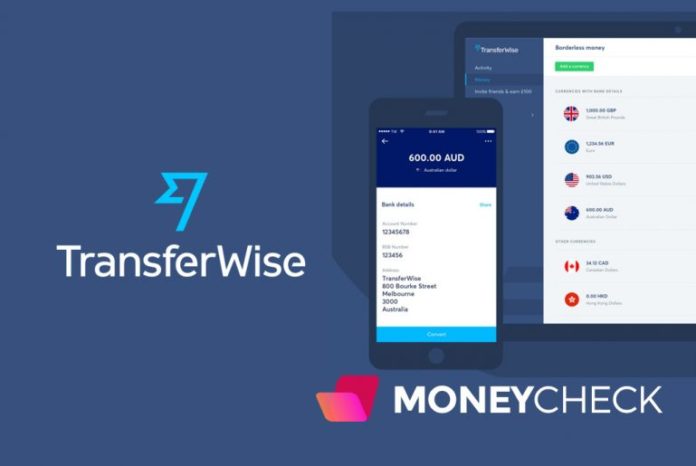We take a close look at Transferwise for Money Transfers & Sending Money Abroad – Is it Safe? What are the Fees? Everything You Need to Know
In a time not so long ago, attempting to send and receive money on a cross-border basis was a financial and logistical nightmare.
Irrespective of whether you use your local bank or a money transfer company like Western Union – you would not only be accustomed to hefty fees and long delays, but you’d also need to sign countless documents.
Fast forward to 2022 and it is now possible to transfer funds overseas at the click of a button – both quickly and cheaply. One of the leading online platforms in this respect is TransferWise.
As such, if you’re thinking about using Transferwise for your international transfer needs, be sure to read our in-depth review.
We’ve covered everything that you need to know, such as how the platform works, fees, transfer times, regulation, safety, and more.
Let’s start by getting an overview of what Transferwise is.
 |
Transferwise Money Transfers – Visit |
|---|---|
| Transfer Type | Online Only |
| Fees | $2 up to $400 / ~0.5% Over $400 |
| Transfer Speed | From Same Day |
| Mobile App |  |
| Min Transfer | £1 / $1 |
What is TransferWise?
Launched in 2011 and founded by Taavet Hinriku and Kristo Käärmann – Transferwise is a money transfer service company that operates purely online.
The founders launched the platform with the view of revolutionizing the cross-border payments sector, insofar that they wanted to bring more competitive foreign exchange fees to everyday consumers.
In order to achieve this, the overarching concept of TransferWise that they offer customers the mid-market exchange rate on their chosen currency pairs.
This is in stark contrast to traditional financial institutions, who will all-but certainly add a percentage on top of the market rate that they get. We’ll explain how this works in more detail further down.
Nevertheless, the TransferWise platform has become so popular that it now serves 6 million customers across 59 individual counties.
With offices now located in 12 different nations, the platform also claims that it facilitates $4 billion worth of international transfers each and every month, subsequently saving customers $1 billion per year – had they gone the traditional route.
As the company behind TransferWise has grown in size, its product range has followed suit. One such example of this is its Borderless Account offering.
This makes the money transfer process is easier, not least because account holders will have access to a fully-fledged Prepaid Mastercard.
As we will discuss further down, the Borderless Account also comes with localized bank account numbers across multiple jurisdictions, including the US, UK, Australia, and New Zealand.
So now that you have an idea of what it is that TransferWise does, in the next section we are going to unravel how the platform is able to offer super-low rates.
Why is TransferWise so Much Cheaper?
First and foremost, in order to understand how TransferWise is able to under-cut traditional banks and money transfer companies, it is important to gain an understanding of how cross-border exchange rates typically work.
Mid-Market Rates
Otherwise referred to as the interbank rate – the mid-market rate is the difference between the buy and sell price of two native currencies. In layman terms, this is what an institutional buyer is prepared to pay for the currency, against the price that an institutional seller is prepared to sell it for.
After all, it is large-scale banks and financial institutions that ultimately drive real-time currency prices.
Let’s take the US Dollar (USD) and British Pound as an example currency pair (GBP/USD).
If an institutional buyer was prepared to pay 1.4 USD against GBP, and an institutional seller was prepared to sell it at 1.6 USD against GBP, then the mid-market rate would be 1.5 USD/GBP.
With that being said, when you search for your chosen exchange rate on Google, the rate that you are presented is in fact the mid-market rate.
Do I get the Mid-Market Rate?
Although the difference between the buy and sell rate will dictate the mid-market rate that large-scale institutions are able to get – unfortunately, this is not the rate that everyday consumers will get when they transfer money abroad.
On the contrary, you’ll pay a hefty mark-up on this rate, subsequently netting banks a somewhat tidy profit.
In terms of the charge itself, this will typically be a percentage mark-up, a flat fee, and a combination of the two. It is not uncommon for money transfer companies to offer something along the lines of ‘0% Commission’ or ‘No Fee Markups’.
However, while you might not pay a fee per-say, you do this indirectly with the specific exchange rate that you are offered.
TransferWise themselves offer a simple example of how this can impact you, which we’ve highlighted below:
- The current GBP/EUR mid-market rate is £1 = €1.43
- As such, by converting £1,000 into Euros, you should receive €1,430.
- However, you only receive €1,370, meaning that you effectively receive a rate of 1.37, not 1.43.
- The difference between the two rates (1.37 and 1.43) is the profit made by the underlying transfer company.
So now that you know how the mid-market rate works – and that you’ll typically receive a much worse exchange rate than what traditional banks are able to get themselves, let’s explore how much TransferWise costs in comparison.
How Much Does TransferWise Cost?
First and foremost, it is important to note that the specific fees charged by TransferWise will vary considerably depending on a number of key factors.
Notably, this includes the amount that you are sending, the currency you are sending, the currency the beneficiary is receiving, and how you intend on funding the transfer. As such, the best way to gauge just how much TransferWise costs is to look at some examples.
Example 1: Sending $1,000 from the US to India
At the time of writing, the mid-market rate on USD/IDR is 71.2 Rupees for every $1 that you exchange. This means that a $1,000 exchange at the mid-market rate would yield 71,200 IDR.
When using TransferWise for the same exchange, the beneficiary would receive 70,429 IDR. Breaking the fees down, this includes a $7.08 fixed fee charged by TransferWise and a $2 ACH fee to fund the transfer.
However, if you were to use a wire transfer, this would cost $5.34. Moreover, a debit and credit card deposit would cost $7.44 and $32.88, respectively. As such, you would be best advised to avoid using a credit card to fund your TransferWise transfer.
Nevertheless, the above example illustrates that you do in fact get the mid-market rate from TransferWise, less the aforementioned $9.08 fees (more if you don’t use ACH) – which is then indirectly built into the exchange rate.
In comparison, the exact same transfer with leading money transfer company MoneyGram would leave the receiver with just 69,425 IDR. This includes a $14.99 debit/credit card fee.
Example 2: Sending $1,000 to the UK
In our second example, we looked at how much it would cost to send $1,000 to the UK. At the time of the comparison, TransferWise quoted £0.81 for every $1 that you transfer. Built within this fee was a $7.21 TransferWise fee, which included the $2 ACH deposit.
With that being said, a $1,000 transfer would leave the beneficiary with £804.15. In comparison, although Western Union only charged a $2.99 fixed fee for the very same transfer, the exchange rate that we were quoted was £0.76 per $1.
As such, the beneficiary only receives £760.10. In comparison to using TransferWise, the Western Union transfer would leave the receiver with £44.05 less.
This example further highlights the point that we discussed earlier on hidden fees, insofar that although Western Union charges a lower fixed fee, they are actually more expensive as the exchange rate on offer is significantly less favorable in comparison to TransferWise.
Example 3: TransferWise vs a Traditional US Bank
Although the exact fees will vary depending on which bank you use, this is by far the worst way of transferring funds overseas. First and foremost, you will likely need to visit your local branch and sign a range of documents before the bank is able to execute the transfer.
Next, as the bank will need to use the SWIFT network, the beneficiary will likely need to wait 3 working days before they receive the funds.
Finally – and perhaps most importantly, you’ll pay huge fees – both directly and indirectly.
Firstly, financial institutions like Chase Bank will typically charge a fixed fee of $45 for facilitating an in-branch international transfer. Secondly, it would not be unusual for the bank to add 3%-5% on top of the mid-market rate that they are able to get.
As such, irrespective of where you are sending money to and for how much, TransferWise will always be cheaper.
How Does the Money Transfer Process Work?
So now that you know how much cheaper TransferWise is in comparison to traditional banks and established money transfer companies, let’s take a look at how the process typically works.

Step 1: Enter transfer details
Your first port of call will be to head over to the TransferWise homepage and choose the currency that you are sending, and the currency that the beneficiary will be receiving.
For example, if you’re looking to send money from the US to your friend in Germany, then you’ll need to select USD and EUR.
The great thing about TransferWise is that they are very transparent on how much they charge.
As such, when you enter the amount that you want to send, TransferWise will not only show you how much the beneficiary will receive, but you can also break the fees down by clicking on ‘See Calculation’.
If you’re happy with the rate offered on screen, click on the ‘Get Started’ button.
Step 2: Enter the details of the beneficiary
The next stage will require you to enter the bank account details of the person you want to send the money to.
Much in the same way as any other bank transfer, you’ll need to enter the receiver’s full name, BIC number, and IBAN. You will also be prompted to enter a reference number of your choosing.
Make sure that these details are correct, as TransferWise will not be held responsible in the event that the funds are sent to the wrong account.
Step 3: Choose your payment method
You will now be asked how you would like to fund the payment. Don’t forget, TransferWise is an online-only company, so you won’t be able to deposit funds in-person.
Nevertheless, the specific payment options available to you will depend on where you are located. If you’re based in the US, then you can pay via ACH, wire transfer, debit card, or credit card.
As we briefly noted earlier, ACH is by far the cheapest option, as it only costs $2 per transfer.
Step 4: Transfer the funds
If you are using a debit or credit card, then you simply need to follow the on-screen instructions, as the entire process is facilitated by TransferWise. However, if you’re looking to pay via ACH or a bank wire, then you’ll need to complete the process externally.
TransferWise will give you the account details that you need to send the funds to, alongside a unique reference number.
It is imperative that you include the reference number within your transfer, otherwise, this will delay the transaction.
Moreover, you also need to ensure that the name associated with your bank account matches the name you entered with TransferWise, and the amount that you transfer needs to match the TransferWise amount to the ‘cent’.
Step 5: Wait for email confirmation
Once you have made the required transfer (or paid by debit/credit card), TransferWise will notify you via email once the funds have been received.
Once they have, TransferWise will then execute your transfer. We’ll discuss time-frames in more detail in the next section.
How Long do TransferWise Payments Take?
Once again, the amount of time that it will take for the beneficiary to receive the money will depend on a number of factors. As per the TransferWise platform itself, this covers four main metrics.
Location of sender and receiver
The main factor that will influence the transfer time is the location of the sender and receiver. Firstly, this covers the specific currencies involved.
For example, if you were sending US dollars, and the beneficiary was receiving British Pounds, then the transfer would be ultra-fast, not least because both USD/GBP are major currencies.
On the contrary, if you were transferring funds from the US over to Kenya, then this could take up to 2 working days to execute, as the Kenyan Shilling is an illiquid currency.
TransferWise also notes that the transfer time can be influenced by the beneficiary’s respective bank. For example, while some financial institutions have the capacity to credit customer deposits instantly, others only do this once a day.
Nevertheless, when you go through the TransferWise payments process, the platform will give you an estimated time-frame.
Payment Method
If you are funding your TransferWise payment with a debit or credit card, the payment will be taken instantly. This means that the platform will execute your transfer straightaway, subsequently speeding up the transfer by some distance.
On the other hand, paying with ACH or bank wire will take much longer. Not only do you need to wait for your bank to transfer the funds, but you also need to wait for TransferWise to confirm receipt.
Ultimately, when it comes to payment methods, you need to weigh up whether you want to prioritize fees or speed. While a debit/credit card deposit is much faster, it is also much more expensive.
Verification
There might come a time where TransferWise requires additional information from you before they are able to execute the transfer. In most cases, you will be able to transfer funds without needing to upload any verification documents, as TransferWise can validate your information via third-party sources.
However, if they are unable to do this, then you might be asked to upload a copy of your government-issued ID (passport or driver’s license) and proof of address (utility bill, tax statement, bank account statement, etc). Although this will delay the funding process, you will only need to verify your identity once.
Time of Transfer
Finally, the time and day that you execute the transfer can have an impact on the transfer time. From the perspective of TransferWise themselves, the platform can only transfer your funds during standard working hours. As such, payments made in the evenings or over the weekend will be delayed.
At the other end of the spectrum, you also need to factor in public holidays in the receiver’s home nation. This is beyond the control of TransferWise, so be sure to check this with the beneficiary before executing the payment.
TransferWise Borderless Account
With the challenger banking space hotting up in recent years, TransferWise has decided to enter the sector with it’s Borderless Account. The account is ideal if you have a requirement to send and receive funds internationally on a regular basis, as it supports up to 40 different currencies.
When you register for an account, you will have access to local bank accounts in five different counties. This includes the UK, US, Australia, New Zealand, and Europe (SEPA). In doing so, you’ll be given a unique account number, subsequently allowing you to accept payments with ease.
Moreover, the Borderless Account also comes with a fully-fledged MasterCard. This not only allows you to make purchases online and in-store, but you can also withdraw cash from ATMs worldwide.
With everything facilitated via the native mobile app (Android and iOS only), whenever you make an international transfer you’ll benefit from mid-market rates. In even better news, you will not be required to pay any monthly fees, nor does it cost anything to open – other than an initial $20 deposit.
In terms of ATM withdrawals, you can take out $250 every month without incurring any fees. However, after this you will be charged 2% of the transaction amount.
Take note, although you will benefit from mid-market rates when making a bank-to-bank transfer, you will pay a fee when using your MasterCard in a currency other than your own. This can vary from just 0.45%, up to a whopping 3% – so do check this before making the payment.
TransferWise vs. UK high street banks
| Compare the costs | Transferwise | Barclays | Lloyds | Santander |
| Send £250 to EUR | £1.54 | £7.89 | £18.73 | £23.55 |
| Spend £250 on debit card in EUR | 83p | £15.66 | £17.43 | £16.91 |
| Withdraw £250 / month cash in EUR | £1.76 | £17.14 | £18.40 | £20.64 |
| Receive AUD, EUR, GBP and USD into your account | Free | N/A | N/A | N/A |
Is TransferWise Safe?
You should have no concerns regarding safety when using TransferWise. Firstly, the UK-based institution is authorized and licensed as an Authorised Electronic Money Institution by the Financial Conduct Authority (FCA). This ensures that the platform has a stringent regulatory watchdog overseeing its operations.
Moreover, the company is registered with the Financial Crimes Enforcement Network (FinCEN) in the US, and regulated by the Australian Securities and Investments Commission (ASIC).
TransferWise also notes that it keeps client funds in segregated bank accounts, meaning that your money is safe in the event that the entity collapsed.
Finally, you will also benefit from two-factor authentication (2FA) when accessing your TransferWise account, which adds an extra layer of security on your funds.
TransferWise Review: The Bottom Line?
In summary, although TransferWise isn’t the only online money transfer platform that has completely revolutionized the cross-border payments system, it’s certainly up there with the best of them.
No longer do you need to pay extortionate fees when sending money overseas, nor do you need to wait for days on end for the transfer to be executed.
On the contrary, TransferWise has the ability to save you a considerable amount of money in exchange fees, all of which can be completed at the click of a button. We also like the fact that you have a number of payment options to choose from, such as ACH, bank wire, or a debit/credit card.
Finally, it is well worth considering the TransferWise Borderless Account if you have a requirement to send and receive funds internationally on a regular basis.
Not only will you benefit from mid-market exchange rates around the clock, but you’ll also be given a localized bank account in five different countries.










































